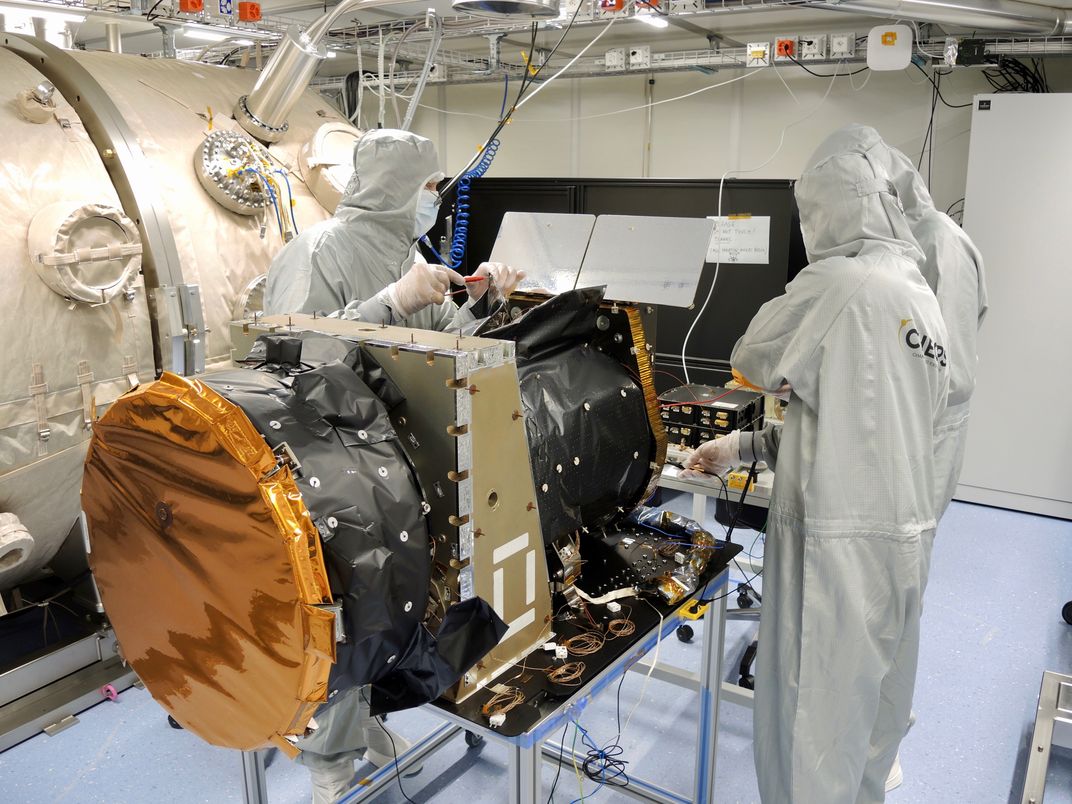Three Things to Know About Europe’s New Exoplanet Space Telescope
CHEOPS is the first exoplanet satellite devoted specifically to learning more about the thousands of planets we have already found
/https://tf-cmsv2-smithsonianmag-media.s3.amazonaws.com/filer/a2/42/a2429182-338a-40db-8b0a-a5eefe24ba0b/cheops_esa_s_first_exoplanet_mission.jpg)
Home to all life as we know it, Earth certainly has a special place in our universe. But it’s probably not the only habitable planet in the cosmos—and scientists are dead set on finding and understanding as many as they can.
Today, the European Space Agency (ESA) ratcheted up the search with the launch of its new telescope, the CHaracterising ExOPlanets Satellite (CHEOPS). Originally scheduled for liftoff from Kourou, French Guiana, on the morning of December 17, the probe’s departure was delayed at the last minute by officials citing a software error.
But just before 4 a.m. Eastern time on Wednesday, December 18, CHEOPS finally took flight. Here’s what you need to know.
CHEOPS is a focused study of known exoplanets
Compared to exoplanet hunters like NASA’s TESS, a satellite currently scouring the skies for new bodies orbiting distant dwarf stars, CHEOPS’ mission is a little different. Rather than turning its lens to the unknown, this satellite plans to focus on some of the 4,000-plus exoplanets previous missions have already identified—and find out as much about them as it can.
“Detecting exoplanets is now the norm,” Matt Griffin, an astronomer at Cardiff University in the United Kingdom, tells Jonathan O’Callaghan at Nature News. “But we need to move into a new era in which we start to characterize and measure their detailed properties.”
To accomplish this, CHEOPS will observe nearby stars already known to host their own planets that fall between Earth and Neptune, the most mid-sized planets in our solar system, in diameter. Because these planets can’t be seen up close, the satellite will measure them indirectly, waiting for blips in the brightness of their stars—an indication that a planet has passed in front of them.
One of the most important important measurements CHEOPS will home in on is the size of various exoplanets that astronomers have already made mass estimates for. Those two numbers combined give scientists enough information to calculate density, a critical metric that can hint at a planet’s composition. Researchers are expecting some targets to be rocky like Earth, while others might be gassy like Neptune, or perhaps rich in subsurface water.

An unusual orbit for an unusual mission
Launched on a Soyuz-Fregat rocket, CHEOPS will settle into orbit about 500 miles above Earth’s surface, circling the planet's poles from north to south. To ensure maximal access to prime image-snapping conditions—that is, dark skies—the satellite will always keep its main instrument pointed toward the side of Earth experiencing night, or away from the sun.
The $55-million spacecraft isn’t a big one, measuring just five feet on each side, a fraction of the size of the Hubble Space Telescope. But its plan is ambitious: From April 2020, onward, CHEOPS will study between 300 and 500 worlds in just three and a half years.
Several times a day, CHEOPS will communicate with a ground station near Madrid, Spain, sending astronomers a steady stream of data in exchange for further commands.
CHEOPS sets the stage for future missions
CHEOPS’ mission might sound cut and dry, but the measurements it takes could help scientists answer some lingering questions about the origin and evolution of planets around the galaxy. Knowing what lies at the heart of other small, rocky planets, for instance, could clue researchers in to the crucial ingredients that help them come together, explains Kate Isaak, a CHEOPS project scientist at the European Space Research and Technology Centre in the Netherlands, in an interview with O’Callaghan.
The list of hundreds of planets CHEOPS turns its eye on will also be whittled down by the satellite’s observations, identifying the most promising candidates for future study.
Though CHEOPS is the first “follow-up” space surveyor of exoplanets, it won’t be the last. The highly-anticipated James Webb Space Telescope, scheduled to launch in the early 2020s, will be one of several crafts joining the search. The ESA will also deploy the PLAnetary Transits and Oscillations of stars (PLATO) and Atmospheric Remote-sensing Infrared Exoplanet Large-survey (ARIEL) missions in the late 2020s to further investigate new worlds, according to a statement. Together, the three probes will collect data on planets that exhibit potential glimmers of habitability—ones that orbit their stars at a distance conducive to the existence of liquid water, for instance, or harbor atmospheres that resemble our own.
“We are very much looking forward ... to [following] up on some of the known exoplanets in more detail,” Isaak said in a statement in July. The launch, she said, is just “the beginning of our scientific adventure.”
/https://tf-cmsv2-smithsonianmag-media.s3.amazonaws.com/accounts/headshot/10172852_10152012979290896_320129237_n.jpg)
/https://tf-cmsv2-smithsonianmag-media.s3.amazonaws.com/accounts/headshot/10172852_10152012979290896_320129237_n.jpg)